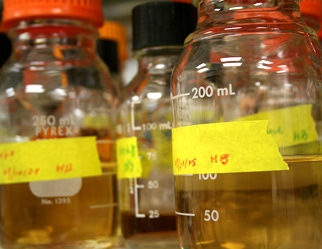Are packaging chemicals safe? Toxicologists say risks are overstated
January 29, 2014

From baby bottles to shower curtains, iPods to lipstick, and “new car smell” to non-stick frying pans, thousands of news stories have warned the American public about the hidden dangers of toxic chemicals in everyday items. But a groundbreaking new survey of scientists specializing in toxicology calls into question the risks associated with many of these chemicals as they are routinely depicted in the media.
Majorities of toxicologists rate most government agencies as accurately portraying chemical risks, but they rate leading environmental activist groups as overstating risks, according to the survey by George Mason University researchers.
Furthermore, the study shows that WebMD and Wikipedia are seen as more reliable than traditional news sources for information about chemical risks:
56% say WebMD accurately portrays chemical risks
45% say Wikipedia accurately portrays chemical risks
By contrast, no more than 15% say that leading national newspapers, news magazines, and television networks accurately portray chemical risks
Over 80% say that leading national newspapers, news magazines, and television networks overstate chemical risks
This survey of 937 members of the Society of Toxicology (SOT) was administered online from Jan 27 to March 2 by Harris Interactive on behalf of the Statistical Assessment Service (STATS) and Center for Health and Risk Communication at George Mason University.
According to survey director Dr. Robert Lichter, “This survey suggests that the public doesn’t get a full and balanced picture of chemical risk.” SOT Vice-President Dr. Michael Holsapple adds, “Ultimately, the media and scientists share the responsibility for how chemical risks are portrayed to the public.”
OTHER MAJOR FINDINGS
Toxicologists Rate Chemical Safety and Regulation
When asked to agree or disagree with statements about chemical safety and regulation:
26% believe cosmetics pose a significant health risk
33% believe food additives pose a significant health risk
55% believe pesticides pose a significant health risk
53% believe chemicals cause endocrine disruption
Only 10% believe organic or “natural” products are inherently safer
Only 6% believe that any exposure to a harmful chemical is unacceptable
69% say chemicals do not need to be regulated according to the precautionary principle
Only 23% say the U.S. regulatory system is inferior to Europe’s
54% say U.S. regulators are not doing a good job explaining chemical risks
"Rate the Risks of Specific Chemicals"
Despite recent controversies in the news over the safety of commonly used chemicals, few toxicologists believe they pose a high health risk.
3% see Teflon as having a high degree of risk
3% see genetically modified organisms as high risk
9% see Bisphenol A, a component of many plastics, as high risk
11% see phthalates, which make vinyl flexible, as high risk
12% see high fructose corn syrup, used in soft drinks, as high risk
By comparison, 26% rate sunlight as posing a high health risk, as do 29% for aflatoxin, a naturally-occurring fungus found in peanut butter, and 35% for mercury.
"Rate How Organizations Portray Risks"
Toxicologists overwhelmingly say that environmental activist groups overstate the health risks of chemicals. But they also say industry groups underplay the risks.
96% say Greenpeace overstates the health risks of chemicals
80% say the Environmental Defense Fund overstates chemical risks
79% say the Environmental Working Group, Natural Resources Defense Council, and Center for Science in the Public Interest overstate the risks
57% say the American Chemistry Council understates chemical risks
60% say the Pharmaceutical Research and Manufacturers of America (PhRMA) understates chemical risks
In contrast, majorities say that most U.S. governmental agencies accurately portray risk, with only the EPA (40%) and the CPSC (47%) falling below a majority.
"Rate the Media Coverage"
Toxicologists almost unanimously believe the media does a poor job covering basic scientific concepts and explaining risk.
90% say media coverage of risk lacks balance and diversity
97% say the media doesn’t distinguish good studies from bad studies
96% say the media doesn’t distinguish correlation from causation
96% say the media doesn’t explain that “the dose makes the poison.”
Almost three out of four toxicologists believe the news media pays too much attention to individual studies as opposed to the overall evidence (74%), and to individual scientists as opposed to the broader community (73%)
Over two out of three toxicologists (68%) believe the news media pays too much attention to studies put out by environmental groups, compared to only 27% and 18% who see too much media attention to studies by government and private sector scientists, respectively
To view the survey online, go to http://stats.org/stories/2009/are_chemicals_killing_us.html
Source: Society of Toxicology
You May Also Like


